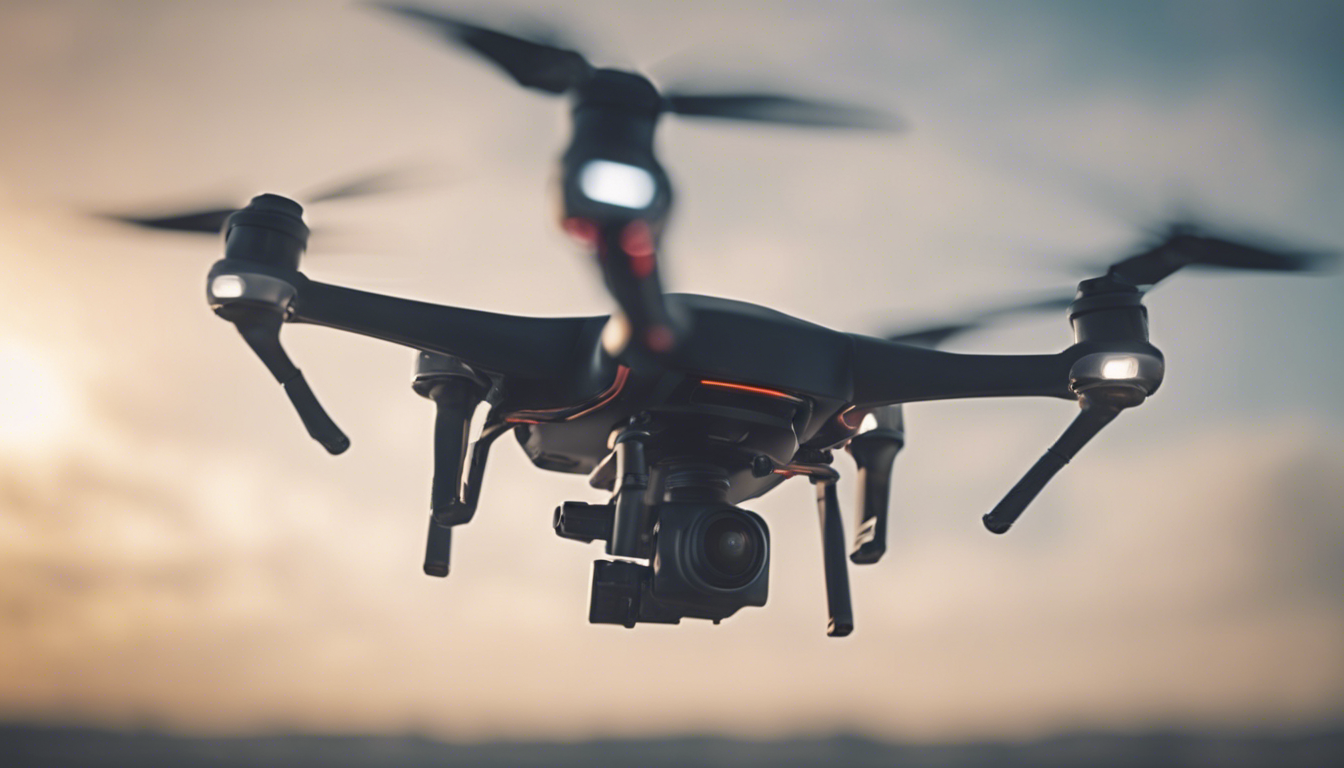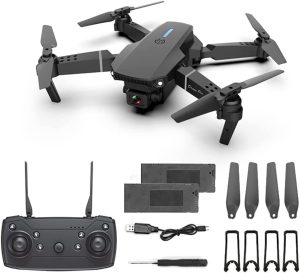
The Rise of Precision Agriculture: An Overview
Imagine a farmer, decades ago, tending to vast fields with little more than intuition and experience to guide them. Now, enter the age of precision agriculture—an era where technology melds with farming practices to produce remarkable changes in how we grow our food. At the heart of this revolution is a surprising, yet increasingly familiar aerial ally: the drone.
A blend of GPS mapping, data analytics, and the tireless whir of propellers above farmlands marks today’s agricultural landscape. Farmers are no longer just workers of the land; they’ve become savvy data analysts, using high-flying gadgets that capture a level of detail about their crops previously unattainable with the human eye alone.
We’re talking about adjustments being made down to the square inch in fields that span acres upon acres. That is like finetuning a giant green canvas with the precision of a master artist, ensuring each crop has its moment in the sun—literally. You see, drones do more than just hover; they collect essential data on crop health, soil conditions, and even monitor irrigation levels to make sure not a single drop of water goes to waste.
Fun fact: drones are also disrupting the traditional image of a scarecrow. Equipped with special sensors and maybe a bit of swagger, these mechanical scouts can deter pests and birds, all while gathering helpful insights about the land below. It’s safe to say that our feathered friends might just respect technology’s boundaries more than old-school straw-and-flannel effigies.
This high-tech approach isn’t purely about staying trendy on the farm, though. Precision agriculture is answering a pressing call to feed an ever-growing global population while reducing waste, conserving vital resources, and lowering environmental impacts. Drones play a starring role in this movement, serving as the eyes in the sky that guide the green thumbs on the ground.
With fields becoming datasets and tractors taking cues from flying robots, it is clear that the bucolic image of farming is getting a digital makeover. And while drones may be the talk of the town now, they’re just the starting point for a series of innovations set to redefine what it means to till, plant, and harvest in the pursuit of plentiful and sustainable yields. Strap in, because that is just the opening act in the age of precision agriculture, and it’s poised to take us to new heights—quite literally!
Optimizing Crop Management with UAV Technology
Now, let’s zoom in on those buzzing beacons of agriculture—the drones that have taken crop management from an art to a science. Imagine a farmer, not so long ago, pacing through rows of crops, trying to spot signs of distress with their bare eyes. Fast forward to today, and you find these modern-day farmers armed with remotes, launching their drones to do the legwork—or should we say “prop-work”? These agile UAVs are equipped with all sorts of high-tech sensors that track plant growth, detect weeds, and even sniff out crop diseases, much like a trusty farm dog might round up sheep.
It’s a bird, it’s a plane—nope, it’s a drone zipping across the sky, rigged up with some snazzy multispectral cameras. These aren’t your typical holiday snaps from the air; they’re capturing images that reveal the secret life of plants. The cameras pick up different wavelengths of light not visible to the human eye, allowing farmers to see the chlorophyll content or water stress levels in their crops. This level of insight is gold for farmers looking to optimize yields—a hidden patch of drought-stressed plants can now be spotted and treated before it hits the dinner plates.
But there’s more to these flying marvels than just playing paparazzi with the plants. Drones help target areas that need fertilizing, which means they can zip around and perform spot treatments, rather than blanketing an entire field with nutrients. This isn’t just good for farmers’ wallets but also for Mother Nature. By pinpointing exactly where and when fertilizers are required, we reduce runoff into nearby streams and rivers, which helps keep ecosystems happy and healthy.
Here’s a fun snippet for you: some of these UAV maestros can even take the reins when it comes to planting. Yup, certain drones are designed to fire seed pods into prepared soil, each one complete with nutrients needed for the best start in life. It’s like playing a video game where every shot must help elevate the earth’s green carpet to perfection.
And let’s not forget about H2O—water—the essence of life and a resource that is often in short supply. Drones come to the rescue here too! They do flyovers that assess how much water crops are guzzling up, leading to more efficient irrigation schedules. By analyzing thermal images taken from up above, it becomes clear where the thirsty spots are in a field. This means farmers can follow a more tailored watering routine instead of letting sprinklers run amok. And with that, drones become unsung heroes in conserving our precious water resources.
So next time you hear a faint buzzing over a field of waving grains, remember there’s a good chance it’s not just nature’s soundtrack—it may well be another mission in precision agriculture underway. Farmers and their drone sidekicks are quietly revolutionizing the way we sustain our future—one flight at a time. With these friendly flyers leading the charge in optimizing crop management, ‘working smarter not harder’ takes on a whole new altitude!
Advancements in Drone-Enabled Farm Monitoring
And now, another twist in the tale of tech-driven farming! The drones dotting our skies are getting brainier, adding layers of sophisticated software to their repertoire. They’re becoming more than just flying cameras—they’re analysts, and they’re transforming the game of farm management with each sweep over our fields.
Thanks to drones, farmers can now read the pulse of their land with a clarity that was once the stuff of sci-fi fantasies. These aerial ace detectives are sniffing out problems like experts tracking clues. They’re picking up on subtle changes in plant health that could signify an infestation or disease lurking beneath what might look like a healthy green patchwork quilt to the untrained eye.
Imagine processing gigabytes of data with each flight, as drones stitch together a high-res picture of the farming landscape. It’s like having a superpower where you see not in mere colors but in a spectrum of crop vitality, moisture levels, and more. The images they bring back are crunched into actionable insights using powerful algorithms that can predict outcomes with eerie precision.
“Drones: From novelties to necessities in modern farming.”
While we marvel at this, maybe you haven’t heard about the drone swarms—yes, swarms—that sync up for coordinated missions. Picture a ballet in the sky as they map out, sample, and monitor vast acres in a synchronized dance that human hands just can’t match for speed and precision.
But wait, there’s a plot twist! It’s not always about what’s going on above ground. Some drones are diving deep, armed with ground-penetrating radars that glimpse into the soil itself. These beneath-the-surface scans bring a wealth of knowledge about root systems and soil health. Remember, it is what’s underneath that often counts!
“Drone whispers”—a term you might not be familiar with—refers to those who interpret the whispers of data from drone flights. These whispers shed light on nutrient levels, enabling precise fertilizer application and even hint at the best times to harvest. Such meticulous detail was once lost in the broader strokes of traditional farming methods.
- Spotting irrigation leaks? Check.
- Calculating the optimal time for pesticide application? Double-check.
- Ensuring each plant plays its part in maximizing yield? A resounding yes.
That is the era where every droplet of water and sprinkle of fertilizer counts more than ever—thanks in large part to our high-flying friends. Plugging into this data-driven network, farmers are equipped to tackle everything from mundane tasks to emergency interventions with a level of precision that would make any old-school farmer do a double-take.
Drones are nailing their roles as custodians of crop efficiency, all the while keeping one robotic eye on sustainability. Who knew that buzzing overhead could signal such a boon for both farmers and the environment?
So, next time you munch on that cob of corn or slice up some juicy watermelon, remember it might have been part of a field once surveyed by flying robots, meticulously ensuring your food was grown with extraordinary attention to detail. Drones in agriculture—silent yet indispensable farmhands patrolling the digital frontier of the world’s breadbaskets.
Future Trends in Drone Agriculture and Sustainability
Imagine waking up to a world where farming is not just about tilling the earth; it’s about nurturing it with high-flying precision and an eco-conscious heart. The drones of today pave the way for futuristic farms where eco-efficiency reigns supreme. It’s here, in these green fields of the future, that drone technology is expected to blossom in ways that are not just smart, but kind to our planet.
One stunning prospect on the horizon is the merger of drone tech with renewable energy sources. Ponder solar-powered drones, autonomously patrolling the skies from dawn till dusk, powered by nothing but the sun’s rays. These guardians of growth would operate independently, freeing farmers from dependency on conventional fuels, and slashing carbon footprints one flight at a time. It’s like having an army of green energy champions, steadfast in their mission to keep our landscapes lush and our air clean.
Don’t say goodbye to the bees— nature’s original pollinators. They’ve been having a tough time lately with populations declining at alarming rates. Enter drone pollinators, designed to mimic the tireless work of our buzzing friends. While they can never replace the vital role bees play in our ecosystem, these robo-pollinators can serve as a stopgap for essential crop fertilization, taking the idea of drones as agricultural aids to new heights.
Beyond pollination, predictive analytics driven by drone-collected data is poised to disrupt farming norms. Farmers will be akin to time travelers, armed with forecasts about each crop’s future, allowing for enlightened decision-making. This could mean knowing which crop varieties will thrive in changing climates or preemptively altering practices to combat impending pest outbreaks.
Now, let’s sprinkle in some artificial intelligence into our ever-growing drone narrative. Picture AI-powered drones that learn and adapt, able to make split-second decisions about crop health, irrigation needs, and more. These aren’t your run-of-the-mill robots; they’re evolving companions—getting smarter with every flight, ensuring sustainable practices aren’t just upheld but continuously improved.
The prospect of drone networks communicating with ground-based autonomous farm machinery is no longer the stuff of fiction. Imagine a combined force where drones in the sky send real-time commands to tractors on the ground for seamless, efficient farming this is in sync with Mother Nature’s rhythm. It’s like conducting an orchestra where each instrument—the drone, the tractor, and the crops—hits the right note for sustainable symphony.
In essence, as we look towards an eco-friendly future for our farms, drones are set to become indispensable allies. They are the vanguard of a farming philosophy that treasures precision just as much as it does purity—purity of method, purity of intent, and ultimately, the purity of the food that graces our tables. So when you next bite into that perfectly ripe piece of fruit or relish a handful of fresh vegetables, know that it might just have been brought to you by a silent, soaring sustainability sentinel.
